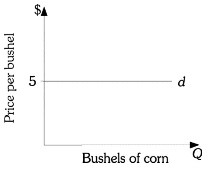Refer to the information provided in Figure 7.1 below to answer the following question(s).  Figure 7.1Refer to Figure 7.1. A corn producer's profit is $1,500 and it is producing 500 bushels of output. Then he must have a cost per bushel of
Figure 7.1Refer to Figure 7.1. A corn producer's profit is $1,500 and it is producing 500 bushels of output. Then he must have a cost per bushel of
A. $1.
B. $2.
C. $3.
D. $4.
Answer: B
You might also like to view...
A firm operating in competitive input and output markets purchases new technology, which shifts the total product schedule from A to B, as shown in the data below.Schedule ASchedule BNumber of WorkersTotal ProductNumber of WorkersTotal Product130135240247348357454465559571663676At the market wage rate of $30 and product price of $5, this firm will
A. increase the number of laborers hired from 4 to 6. B. increase the number of laborers hired from 4 to 5. C. decrease the number of laborers hired from 4 to 3. D. hire the same number of laborers in both situations.
Explain how it might be possible for the total variable cost function to be linear? Explain
What will be an ideal response?
Which of the following is a true statement?
a. The LDC classification is of the questionable accuracy. b. GDP per capita ignores the degree of income distribution. c. GDP per capita is affected by exchange rate changes. d. GDP per capita does not account for the difference in the cost of living among nations. e. All of these are true.
Capital, as economists use the term, refers to
A. The cash needed to start a new business. B. The costs of operating a business. C. Final goods that are used to produce other goods and services. D. Shares of stock issued by businesses.